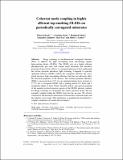Files in this item
Coherent mode coupling in highly efficient top-emitting OLEDs on periodically corrugated substrates
Item metadata
| dc.contributor.author | Schwab, Tobias | |
| dc.contributor.author | Fuchs, Cornelius | |
| dc.contributor.author | Scholz, Reinhard | |
| dc.contributor.author | Zakhidov, Alexander | |
| dc.contributor.author | Leo, Karl | |
| dc.contributor.author | Gather, Malte Christian | |
| dc.date.accessioned | 2014-06-16T10:31:01Z | |
| dc.date.available | 2014-06-16T10:31:01Z | |
| dc.date.issued | 2014-03-25 | |
| dc.identifier | 112455354 | |
| dc.identifier | 4f80a6d8-76da-414f-89a4-a5e5a0c74a94 | |
| dc.identifier | 84898636092 | |
| dc.identifier | 000335898700015 | |
| dc.identifier.citation | Schwab , T , Fuchs , C , Scholz , R , Zakhidov , A , Leo , K & Gather , M C 2014 , ' Coherent mode coupling in highly efficient top-emitting OLEDs on periodically corrugated substrates ' , Optics Express , vol. 22 , no. 7 , pp. 7524-7537 . https://doi.org/10.1364/OE.22.007524 | en |
| dc.identifier.issn | 1094-4087 | |
| dc.identifier.other | ORCID: /0000-0002-4857-5562/work/47136459 | |
| dc.identifier.uri | https://hdl.handle.net/10023/4880 | |
| dc.description | This work was funded by the European Social Fund and the Free State of Saxony through the OrganoMechanics project, and by the AIF/BMWi in the framework IGF under contract no. GF-11/05 resp. AiF-Nr. 16784 BR (project LipsOLED). Support from the excellence cluster cfaed is gratefully acknowledged. We acknowledge support by the German Research Foundation and the Open Access Publication Funds of the TU Dresden. | en |
| dc.description.abstract | Bragg scattering at one-dimensional corrugated substrates allows to improve the light outcoupling from top-emitting organic light-emitting diodes (OLEDs). The OLEDs rely on a highly efficient phosphorescent pin stack and contain metal electrodes that introduce pronounced microcavity effects. A corrugated photoresist layer underneath the bottom electrode introduces light scattering. Compared to optically optimized reference OLEDs without the corrugated substrate, the corrugation increases light outcoupling efficiency but does not adversely affect the electrical properties of the devices. The external quantum efficiency (EQE) is increased from 15 % for an optimized planar layer structure to 17.5 % for a corrugated OLED with a grating period of 1.0mm and a modulation depth of about 70 nm. Detailed analysis and optical modeling of the angular resolved emission spectra of the OLEDs provide evidence for Bragg scattering of waveguided and surface plasmon modes that are normally confined within the OLED stack into the air-cone. We observe constructive and destructive interference between these scattered modes and the radiative cavity mode. This interference is quantitatively described by a complex summation of Lorentz-like resonances. | |
| dc.format.extent | 14 | |
| dc.format.extent | 8746668 | |
| dc.language.iso | eng | |
| dc.relation.ispartof | Optics Express | en |
| dc.subject | Light-emitting diodes | en |
| dc.subject | Microstructure fabrication | en |
| dc.subject | Organic materials | en |
| dc.subject | Gratings | en |
| dc.subject | QC Physics | en |
| dc.subject.lcc | QC | en |
| dc.title | Coherent mode coupling in highly efficient top-emitting OLEDs on periodically corrugated substrates | en |
| dc.type | Journal article | en |
| dc.contributor.institution | University of St Andrews. School of Physics and Astronomy | en |
| dc.contributor.institution | University of St Andrews. Biomedical Sciences Research Complex | en |
| dc.identifier.doi | 10.1364/OE.22.007524 | |
| dc.description.status | Peer reviewed | en |
This item appears in the following Collection(s)
Items in the St Andrews Research Repository are protected by copyright, with all rights reserved, unless otherwise indicated.

